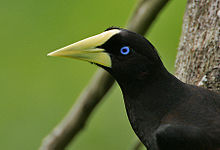- Crested Oropendola
-
Crested Oropendola 
Conservation status Scientific classification Kingdom: Animalia Phylum: Chordata Class: Aves Order: Passeriformes Family: Icteridae Genus: Psarocolius Species: P. decumanus Binomial name Psarocolius decumanus
(Pallas, 1769)The Crested Oropendola, Psarocolius decumanus, is a New World tropical icterid bird. It is a resident breeder in lowland South America east of the Andes, from Panama and Colombia south to northern Argentina, as well as on Trinidad and Tobago. If the genus Gymnostinax for the Montezuma Oropendola and its closest relatives were considered valid, this species would probably belong in that genus (Price & Lanyon 2002).
It is a common bird, seen alone or in small flocks foraging in trees for large insects, fruit and some nectar. The male is 46 cm long and weighs 300g; the smaller female is 37 cm long and weighs 180g.
The plumage of the Crested Oropendola has a musty smell due to the oil from the preen gland.
Contents
Description
Adult males are mainly black with a chestnut rump and a tail which is bright yellow apart from two dark central feathers. There is a long narrow crest which is often difficult to see. The iris is blue and the long bill is whitish. Females are similar but smaller, duller, and crestless.
Taxonomy
There are four subspecies:
- P. d. insularis of Trinidad and Tobago has much chestnut edging on the feathers of the wings and back.
- The nominate subspecies P. d. decumanus occurs from Colombia south to the Amazon in Brazil.
- P. d. maculosus breeds south of the Amazon. It is browner, and has yellow feathers scattered through the body plumage.
- The northern form P. d. melanterus of Panama and western Colombia is very similar, differing only in the amount of chestnut feather tipping, and is of dubious status.
Behaviour
The Crested Oropendola inhabits forest edges and clearings. It is a colonial breeder which builds a hanging woven nest, more than 125 cm long, high in a tree. It lays two blotched blue-grey eggs which hatch in 15–19 days, with another 24–36 days to fledging.
Each colony has a dominant male, which mates with most of the females following an elaborate bowing display. There may be 15-30 females and only 3-4 males. Outside the breeding season, this species is quite mobile, with some seasonal movements.
The distinctive songs of the male include a liquid vibrato CreeeEEEoooooooooo. Both sexes have a loud clack call.
References
- BirdLife International (2004). Psarocolius decumanus. 2006. IUCN Red List of Threatened Species. IUCN 2006. www.iucnredlist.org. Retrieved on 12 May 2006. Database entry includes justification for why this species is of least concern
- ffrench, Richard; O'Neill, John Patton & Eckelberry, Don R. (1991): A guide to the birds of Trinidad and Tobago (2nd edition). Comstock Publishing, Ithaca, N.Y.. ISBN 0-8014-9792-2
- Hilty, Steven L. (2003): Birds of Venezuela. Christopher Helm, London. ISBN 0-7136-6418-5
- Jaramillo, Alvaro & Burke, Peter (1999): New World Blackbirds. Christopher Helm, London. ISBN 0-7136-4333-1
- Price, J. Jordan & Lanyon, Scott M. (2002): A robust phylogeny of the oropendolas: Polyphyly revealed by mitochondrial sequence data. Auk 119(2): 335–348. DOI: 10.1642/0004-8038(2002)119[0335:ARPOTO]2.0.CO;2 PDF fulltext
External links
- Crested Oropendola videos, photos & sounds on the Internet Bird Collection
Categories:- IUCN Red List least concern species
- Oropendolas
- Psarocolius
- Birds of Costa Rica
- Birds of Panama
- Birds of Trinidad and Tobago
- Birds of South America
Wikimedia Foundation. 2010.


